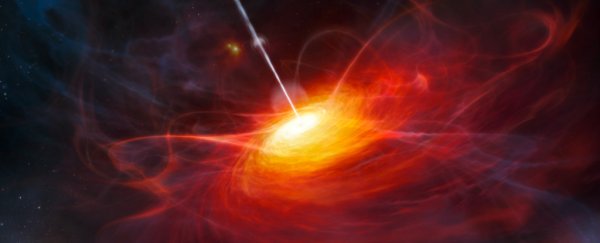This article was written by Ivy Shih and was originally published by The Conversation.
In 2012, a tiny flash of light was detected deep beneath the Antarctic ice. A burst of neutrinos was responsible, and the flash of light was their calling card.
It might not sound momentous, but the flash could give us tantalising insights into one of the most energetic objects in the distant universe.
The light was triggered by the Universe's most elusive particles when they made contact with a remarkable detector, appropriately called IceCube, which was built for the very purpose of capturing rare events such as this.
The team of international researchers now suspect the event may have originated from a quasar, which is the active nucleus of a galaxy billions of light-years away.
The flash also potentially opens up a new era of neutrino astrophysics and may help unravel the mystery of neutrino production in the Universe.
The antisocial particle that came in from the cold
Neutrinos are elementary particles and one of the smallest building blocks of the Universe. Despite being one of the most abundant and energetic particles, neutrinos have a reputation of being notoriously hard to detect.
This is because they very rarely interact with normal matter. In fact, billions of them pass through your body every minute without even causing a tickle.
So how do you find such an antisocial particle?
It might not look it from the frosty surface of Antarctica, but Ice Cube is one of the world's largest telescopes, and the largest for detecting neutrinos.
IceCube occupies a cubic kilometre of clear ice, which provides the best medium for thousands of sensors to capture that elusive burst of light created when a high energy neutrino collides with an ice particle.
Although the probability of a collision is minuscule, there are so many neutrinos that pass through the detector that eventually some will interact with the ice.
The trick then is to determine where the neutrinos originated. Neutrinos are produced by the nuclear reactions going on at the centre of stars and in other highly energetic cosmic processes.
So when trying to find origin of the 2012 neutrino burst, Professor Sergei Gulyaev, the director of Auckland University of Technology's Institute for Radio Astronomy and Space Research told The Conversation that there was no shortage of candidates. The sky was literally the limit.
"Out of millions of astronomical objects, which one was responsible?"
Nucleus of a galaxy
A network of New Zealand, Australian and African radio telescopes searched the skies for what might have triggered the 2012 flash.
But one candidate stood out. Radio astronomers were able to create an image of a distant object that appeared to change dramatically after the neutrino burst was registered in South Pole.
From this, they decided that the most likely source of the neutrinos was a quasar, called PKS 1424-418, located 9.1 billion light years away – nearly at the edge of the visible Universe.
A quasar is the active nucleus of a primordial galaxy with a supermassive black hole at its core.
"We knew before that huge fluxes of very energetic particles came from space. We call them 'cosmic rays'. Neutrinos are part of them. But we had no idea which astronomical objects are responsible for this."
Gulyaev emphasised that they had to be cautious before drawing any conclusions about the source of the neutrinos.
"We were very careful, but combining radio astronomical and gamma-ray observations made by NASA's Fermi gamma-ray space telescope, we now know where or what it is. Given the huge increase in energy, shape change and activity, we are 95 percent sure that a quasar was responsible for the event registered by IceCube."
Gulyaev added that this particular quasar was active while the Universe was very young.
"Quasars are like dinosaurs. They became extinct a long time ago," said Gulyaev. "But because astronomy is like a time machine, we were able to study this quasar."
The study may also open a new window into the distant Universe. Whereas most astronomy is conducted by studying electromagnetic radiation, such as light or radio waves, these can be obscured or distorted as they travel through space.
But because neutrinos pass through most matter, and aren't influenced by magnetic fields, they can pass through vast stretches of the cosmos uninterrupted. If we can detect them reliably, we might be able to observe things we can't normally see.
An exciting problem
Professor Ron Ekers, an astrophysicist from CSIRO, said the study presents tantalising possibilities of an extragalactic origin of the high energy neutrino burst.
However, the true test of time will be if the model can eventually predict future detections alongside more precise measurements of neutrino positions that would be possible in the future.
Ekers said that although the model presents a possible origin, a crucial step would be to increase the level of accuracy in neutrino detection instruments to more precisely pinpoint and narrow down possible sources.
"Current position errors for these neutrinos are quite large and there are many possible objects which could be the source."
Ekers added that both IceCube and the Mediterranean Neutrino Array (KM3NeT) have future plans to greatly improve positional accuracy to fulfil that need.
"Finding out where the high energy neutrinos come from is one of the most exciting problems in astrophysics today. Now we have a possible identification we desperately need to improve the directional accuracy of the neutrino detections."
Ivy Shih, Editor, The Conversation.
This article was originally published by The Conversation. Read the original article.


